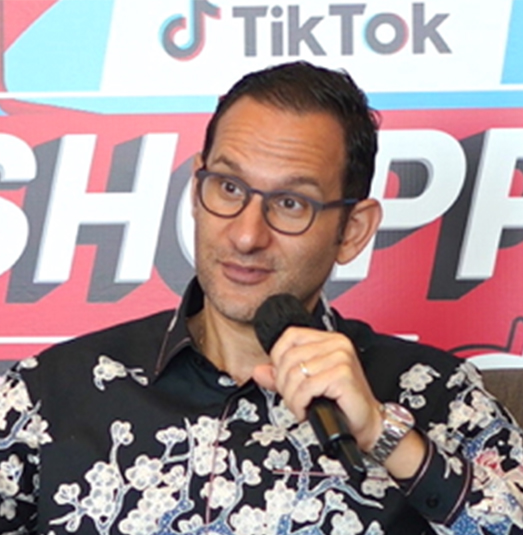With demand for tech solutions being more cautious, cuts in spending by big tech companies and an uncertain outlook for his year, how much have Martech players in the region been impacted?
How are organizations in Asia Pacific (APAC) reacting to market changes, advertising budget cuts and the pressure to deliver a greater ROI for their customers? Has innovation been stymied by the tougher macro-economic environment?
As we move into the second-half of the year, and in the second of three interviews with Martech industry players across Asia to hear their perspectives, we speak with Shant Oknayan, TikTok’s Head of Global Business Solutions – Asia-Pacific, Middle East, Africa & Central Asia, to learn how he sees tech consumer behavior evolving and the prospects for the rest of 2023 and beyond.
With big tech companies cutting costs and fears of a slowdown in 2023, what do you see as the impact on the APAC digital advertising outlook for the year?
We’ve seen a significant shift in the digital advertising landscape. Marketers, in particular, are now actively seeking greater returns despite resource limitations. This shift has prompted marketers to explore new strategies and techniques to optimize their investments in digital advertising.
The good news is that APAC is expected to witness continued growth of digital adoption with technology spend forecasted to accelerate by 5.8%, reaching USD$732 billion. With the rise in internet penetration, smartphone usage, and online platform adoption, the opportunity for marketers to ‘do more with less’ is no longer far-reaching.
Additionally, the changing consumer behavior is also driving brands to change their approach. They are looking for a seamless shopping experience that sparks joy and addresses their functional and emotional demand spaces. At TikTok, we call it Shoppertainment – where content and commerce converges. According to the 2022 Future of Commerce study by TikTok and Boston Consulting Group (BCG), Shoppertainment is a US$1 trillion opportunity in APAC by 2025. We believe that’s where marketers can start to look at optimize their strategy to tap into this opportunity, if they haven’t already.

What is TikTok doing to navigate this uncertain climate?
We will continue to support businesses of all sizes who choose TikTok as their digital marketing platform. The economic challenges today are huge and marketers need to remain agile to keep improving their ROI – testing, learning, and repeating what works in order to drive engagement and results. We will keep abreast of the changing marketing landscape so that we can empower our partners with best practices in creativity and optimization for maximum effectiveness.
Aside from our commitment to supporting businesses of all sizes to optimize their marketing budget, we will also focus on helping them drive innovation to enhance their brand presence on our platform. In our efforts to empower small to medium-sized businesses (SMBs) and drive their success, we have announced a US$12.2 million investment in Southeast Asia aimed at helping more than 120,000 SMBs transition their businesses online and participate in the digital economy. This investment comprises cash grants, digital skills training, and advertising credits for SMBs, including micro businesses, in rural and suburban areas.
We will also continue to develop localised and hyper-relevant content around festive seasons, such as Tet for Vietnam, Ramadan for Indonesia and Malaysia, and launch workshops that help brands of all sizes to be more creative on TikTok. Through this, we hope to create more awareness and provide more insights for brands that are looking to explore or get on board the platform.
What do you see as the opportunities driving growth this year? What trends are changing how we use technology?
About a year ago, we conducted a study with Boston Consulting Group (BCG) to identify the opportunities that lie in the marketing landscape for the region. What we found from this study is that Shoppertainment, which we view as an entertainment-first, commerce-second approach, will be a 1 trillion USD opportunity in APAC by 2025 (500 billion USD in 2022, doubling in 3 years). The six growth markets for this include Indonesia, Vietnam, Thailand, Australia, Korea, and Japan.
This growing trend is a result of changing consumer purchasing habits. Engaging content that enhances a consumer’s emotional connection to products is what will drive purchases from hereon. We would strongly encourage brands to capitalize on this opportunity by effectively telling their stories, educating audiences, fully embracing video content, and recommending trends to ensure that they stay relevant and connected with the consumer.
How are businesses working with TikTok in their digital marketing? Can you share any examples?
There are many ways that businesses can work with TikTok in their digital marketing. For smaller or growing businesses, we provide valuable resources and training programs to help them understand how they can improve their marketing strategies to effectively connect with their target audience. Aside from the advertising credits mentioned above, we do have partnerships with government bodies across Southeast Asia, such as Thailand’s Digital Economy Promotion Agency and Vietnam’s Ministry of Agriculture and Rural Development, to educate and train SMBs that are looking to get on board the platform. For those that are already on the platform, we continuously look at how we can help them reach even more users.
TikTok helps businesses of all sizes grow. For example, McJeans, a leading Thai fashion brand, came onboard TikTok Shop to sell direct-to-consumers. They adopted a robust content strategy, encompassing livestream and product assortment. They launched an affiliate program, encouraging staff to promote their brand on TikTok. They participated on TikTok Shop and brand-owned campaigns, as well as leveraging on Shop Ads to reach a wider audience. They have seen a 2.5x return on ads spend (ROAS), with gross merchandise value (GMV )growth at 18x.
We’re seeing this impact in larger brands as well. Garnier used TikTok to promote the launch of its new serum skincare product. They created a full-funnel strategy that leveraged content creators and a branded hashtag challenge. The retargeted ads that drove more qualified traffic for higher sales conversion to other platforms. Garnier successfully generated new demand and 30% sales uplift on other platforms during the 12.12 shopping festival. Garnier became the #1 serum in the campaign month.
How do these marketing activities lead to greater growth? Creativity. Users are on TikTok to be entertained. TikTok’s tools for making creativity easy for users is well known, but we also have tools to help brands be creative at every stage of the marketing campaigns.
A big part of being creative on TikTok is working with our creators. Klook, a leading digital travel company, sought to develop a promotional campaign to elevate the awareness of Avatar: The Experience, targeting the Southeast Asia region and create travel activation. The challenge was to market a new experience within an iconic destination to key source markets for Gardens By the Bay. Klook enlisted the help of 12 TikTok creators with a collective following of over 27 million. They were flown in from Thailand, Malaysia, Philippines, Indonesia and Vietnam to create high impact and personable videos to give a “trip before the trip” experience to communities.
Creators were tasked with creating livestreams and branded content, including the journey to the event and also highlighting the exciting on-the-ground activations of all five zones of the Pandora world. The nature of the content generated by the creators was visually impactful. Klook was able to generate 1.15 million ad impressions and reach a total of 648,000 unique viewers.
A key issue has been protecting the data privacy of users. How is TikTok working with consumers to ensure data privacy and proper governance when collecting and using data?
We uphold a strong commitment to brand safety, guided by three fundamental principles: safety, transparency, and accountability. We keep our community safe through well-defined policies including those listed in our Community Guidelines, ensuring a safe environment for users and brands alike. Through our Quarterly Community Guidelines Enforcement Reports, we provide visibility into the volume and nature of content and accounts that have been removed from the platform. Moreover, TikTok’s Transparency and Accountability Centers serve as physical hubs where experts and lawmakers can directly observe TikTok’s practices, including content moderation procedures, data security measures, and safeguards for user privacy and information.
Additionally, TikTok also offers various tools for brands to enhance brand safety. Our In-Feed Ads and TopView Ads are designed with 100% share of voice on screen, and the Comment Management Tools ensure that a business’ risk tolerance is respected on the platform. Our TikTok Inventory Filter gives advertisers more control over the type of content that runs next to their In-Feed Ads.
We also have built in Recommendation Transparency and Advertising Transparency options, to help users understand why they see the ads they do. The platform is also TAG Brand Safety Certified and TAG Certified Against Fraud globally, demonstrating TikTok’s adherence to rigorous standards set by the Trustworthy Accountability Group. This certification ensures transparency in digital advertising and upholds brand safety measures. We are also signatory on the Global Alliance for Responsible Media (GARM) Charter & active participant in working groups.
Through these concerted efforts, we remain dedicated to maintaining a secure platform for brands and communities.
What strategies should marketers adopt to stay competitive this year? How can they continue to drive traffic and businesses to their platforms?
Shoppertainment, the convergence of content and commerce, is a $1 trillion opportunity in APAC. That is a tremendous commerce opportunity that is waiting for brands to engage in. 1 in 3 consumers want commerce to be more entertaining, and 75% of TikTok users identify the platform as a home for entertainment.
This all points to the need for a new way for brands and consumers to interact. We recommend that brands tap into this opportunity to
- create Entertainment first experiences,
- respond to users’ elevated needs,
- do not just show up when they have something to sell.
The need for marketers to produce entertaining content means brands must now engage with their own existing content in new and different ways. One way that we see possible is through the creative production framework we provide marketers., for example in optimizing their existing assets to seamlessly fit onto platforms and bringing creative ideas to life using the platform’s power and community. By adopting this approach, brands can engage their audiences with their ideas in multiple ways, amplifying their impact.

















